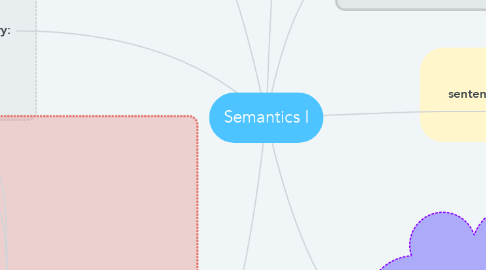Semantics I
by Viviana Pinto

1. fixed vs. fuzzy:
1.1. fixed: identifies the core and basic meaning of a concept. E.g. justice, courage etc.
1.1.1. "Where do I draw the boundaries?"
1.2. fuzzy: meaning of a word is fluid, there is no precise meaning. E.g. game, vase etc.
2. prototype theory:
2.1. practical approach of the compositionality theory, categorisation based on a "prototype".
2.2. + takes the unusual in account, "outskirts"
2.3. - depends on location and culture (red hammer example), members of a one category are matched against the features of a prototype – "doggier dogs" / "birdier birds"
3. list of roles associated:
3.1. agent: an entity causing an action, initiator of an action, e.g. "I" will get you a coffee.
3.2. patient: an entity affected by an action, e.g. I will get "you" a coffee.
3.3. experiencer: an entity that perceives a stimulus or registers a particular mental or emotional process, e.g. "He" liked the smell of freshly mowed lawn.
3.4. stimulus: an entity that causes experience, e.g. Kevin was home alone and heard somebody "closing the door".
3.5. recipient: an entity which receives or acquires something, e.g. Phillipe gave "Vivienne" a kiss.
3.6. instrument: used by an agent to perform some action, e.g. He cut the cucumber with "a knife".
3.7. theme: entity that moves as part of an action, e.g. "The little girl" blushed.
3.8. cause: the thematic role which causes something to happen, but not actively. Usually a natural force, e.g. "The storm" destroyed the house.
3.9. source: the thematic role of a) the place from which movement occurs and b) the original owner in a transfer, e.g. Susan fell off "the balcony".
3.10. goal: place towards which something moves or something towards an action is directed, e.g. Julian got out of the taxi and ran to "university" because he was late.
3.11. location: where something happens, e.g. The mole lives "in the earth".
4. utterance meaning:
4.1. the meaning of an expression when used in a given context of utterance, fixed reference & truth value. E.g. "I'm cold." –> actual meaning: "Turn on the heating!", (s)he's thus making an indirect request.
5. sentence meaning:
5.1. the meaning of a simple or complex expression taken in isolation. E.g. "I'm cold." –> (s)he's actually informing her surroundings and thus making a statement.
6. compositionality:
6.1. a method to analyze and describe a word by listing featured and related words.
6.2. checklist principle: structured sets of semantic features (sèmes). E.g. boy is {+male} {+young}, man is {+male} {-young} and girl is {-male} {+young}.
6.3. Problem: What if a cat has three leg, is it still a cat?
7. thematic roles:
7.1. used to talk about the lexical semantics of words which describe actions, like verbs.
7.2. the roles which the subject and other arguments have in the described by the verb
7.3. –> who did what to whom, for whom etc.
7.4. –> thematic roles are different from syntactic roles (S/O etc)
7.5. the list of roles associated with a particular word is called a thematic grid


